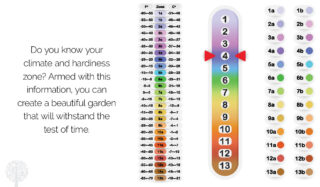Climate and Hardiness Zones: The Key To A Garden’s Survival Through All Seasons
Going to the garden center and buying a new plant is an exciting day for the home gardener, and there are many deals this time of year! Usually, a tag detailing care instructions and, most importantly, a number denoting the plant’s hardiness or climate zone designation is attached to perennials, shrubs, or trees. This label is the key to its longevity and survival.
What Are Hardiness Zones?
Hardiness zones stretch back to the 1960s when Henry Skinner of the United States National Arboretum first developed a working map of plants and their sensitivity to cold.
The US Department of Agriculture (USDA) refined the original vision. Other countries worldwide followed suit, including Canada, Australia, and Britain, which have all created models indicating how well plants withstand the cold winter temperatures within the geographical regions of their countries.
The maps and corresponding charts are color-coded and divided into numbered categories or zones based on the average lowest winter temperatures a plant can survive. The latest US designations were published in 2023 and examined temperature averages from 1991 to 2020.
In Britain, the Royal Horticultural Society’s (RHS) ratings are very specific to a plant’s ability to withstand changeable periods of freezing and relatively mild weather. Its charts show how some plants may tolerate a light frost for a couple of hours and others extended cold.


What are Climate Zones?
While cold is one factor that impacts a plant’s health, it isn’t the only one. Heat, rainfall and humidity also influence survival. Climate zones include all these factors.
The maps and charts are color-coded and divided into numbered zones or regions. The US Sunset Magazine has developed a climate zone map considering all these factors.
In Canada, Natural Resources Canada refined the original USDA map. The most recent publication is based on climate data from 1981-2010, taking in a wide range of variables, including winter temperatures, summer heat, rainfall, snow cover, wind, and elevation.


Why Knowing Your Climate and Hardiness Zone Matters
Climate and hardiness zones significantly impact what I plant and how I prepare my selection for winter weather.
Do I cover the roots with mulch? Or is it better to shelter the plant inside? If it’s particularly hardy, it may handle the harsh outdoor elements just fine.
Knowing my climate zone designation makes a difference in discerning these things. Plants above the hardiness barriers of my Zone 7 region are considered tender perennials. They will not survive winter or the heavy rainfall the south coast of British Columbia is infamous for.
Of course, for every rule, there’s an exception!
Changing Zones
As climate change accelerates, warmer temperatures are creeping northward at about 20km per decade, changing these once-pre-determined zones.
Knowing your region’s current climate and hardiness zone is the best way to make the right choices for your garden as the planet warms and the seasons extend. This ensures that the plants that take root today will be the garden stars of seasons to come.




